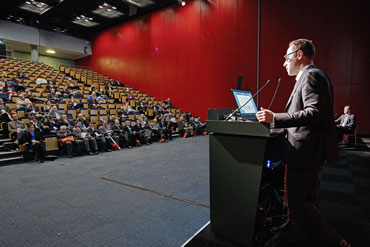The 30th Annual EAU Scientific Meeting this year was held in Madrid on 20-24 March 2015. The meeting took place at the IFEMA Feria de Madrid, which was located 30 minutes from the city center, with-in walking distance from the underground station and just a 10-minute drive from the airport.
It was a very successful meeting attended by more than 14,000 healthcare professionals in different disciplines in the urological field from over 100 countries. More than 1,100 abstracts were accepted for presentation. Madrid this year also welcomed around 300 urology nurses from Europe and around the world.
The scientific program covered all areas of urology and all its subspecialties, providing the delegates great opportunities for professional development. The scientific program included plenary sessions, state-of-the art lectures, hands on training, the educational program of the European school and the live surgery (mainly laparoscopic and robotic).
One of the key aspects of the scientific meeting was to devote a lot of activities and resources towards education and benefit for the attendees.
This year new initiatives were launched such as: online training programs; patient’s information resources; the release of a new journal “The European Urology focus”; the release of the latest EAU guidelines.
The 30th Anniversary EAU Congress also marked the introduction of e-Posters.
As member of the Educational Committee of ICS, I had the honor to attend the EAU meeting in Madrid and to give a state of the art lecture at the EAU Section of Female and Functional Urology (ESFFU) on Saturday 21st of March on behalf of ICS. “The good, the bad and the ugly of pelvic floor aging. Can we preserve its function?” was the title of the presentation. In my presentation I have highlighted the fact that the ageing process plays a negative role in either the function and/or structure of the pelvic floor in women; it contributes to the deterioration of the pre-existing pelvic floor dysfunction during the life span of a woman; it interacts with other predisposing factors such as parity, mode of delivery, menopausal estrogen deficiency, higher BMI, diabetes, etc to cause predominant pelvic floor failure.
The programme of the ESFFU was mainly focused on the functional urological disorders in both men and women. More than 150 members attended the session. The scientific value was very high and the interactive discussion between speakers and the audience very interesting and didactic. Different topics were covered from basic science and adolescent Urology to OAB and BPH. An interesting debate on the role and safety of the synthetic polypropylene mesh in female urology with a particular attention to postoperative pain and erosion closed the session.
It was quite challenging as well as a great honor for an urogynaecologist like me to give a state of the art lecture in one of the most prestigious scientific international urological meeting. Therefore I am deeply grateful to the ICS board, to the Educational Committee and its chair Professor Kocjancic as well as to John Heesakkers and the local organizing committee for their kind invitation. Many sessions have been webcasted and the content of the scientific meeting, including abstracts, (e-)posters, videos are available online.

A review by Alex Digesu, Education Committee Member